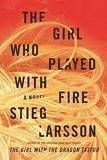The Girl Who Played with Fire / Stieg Larsson
 Knopf / July 2009
Knopf / July 2009
Reviewed by: Beth Harrington
In the sequel to his debut mystery thriller The Girl with the Dragon Tattoo, it seems that Stieg Larsson – who was regrettably not alive to enjoy his literary success – predicted the reactions that readers would have to the characters that he created. Namely, that they would crave to become immersed in the world of the weird, aloof, yet irresistibly brilliant cyber-whiz Lisbeth Salander, who was introduced alongside investigator-cum-journalist Mikael Blomkvist. Thus, in The Girl Who Played With Fire, a sequel that can be read independently of its predecessor, Larsson revolves his novel around the miniscule, introverted heroine who was dubbed “the coolest crime-fighting sidekick to come along in many years” by the Washington Post.
The opening scenes of the novel locate Salander – a recent billionaire due to her hacking enterprises – enjoying a vacation in the Caribbean, studying mathematical texts and drinking rum and cokes as the island prepares for a hurricane. She returns to her native Sweden only to quickly find herself the suspect in a string of homicides that involve two reporters who were going to write an expose` on the sex trade for Millennium, the magazine that Blomkvist edits. The case builds against Salander as the police investigation becomes tainted by corruption and fixates on salacious tabloid motives regarding Salander’s tumultuous teenage years spent in mental institutions and foster homes, as well as her unorthodox friends — an S&M dominatrix and a fringe rock band. Nevertheless, Salander manages to accrue a diverse group of allies, including her former employer at a prestigious security firm, a renowned boxing champion, and Blomkvist himself.
In The Girl Who Played with Fire, Larsson has revived a cast of characters who are vivid, likeable, and usually complex. Readers who loved The Girl with the Dragon Tattoo will really appreciate Salander’s cleverness and unassuming wit in evading capture by the bumbling and bigoted police force, as well as the fleshed-out details of her past. A third-person omniscient narrative allows the point-of-view to skip between characters, revealing the motivations of Blomkvist, Salander, the police detectives, and even the killers themselves as their identities begin to emerge.
The primary problem with The Girl Who Played with Fire is its length: a whopping five hundred and twelve pages. It is actually not so much the book’s length but rather why the book is so long that constitutes the issue. Larsson crams his text with the most mundane details of his characters’ ordinary lives. Every meal, every article of clothing, and every coffee and cigarette break taken by a major character is recorded. In the context of some thrillers, the minutiae of characters’ lives can subtly reveal valuable clues that guide readers in the direction of identifying the culprit, but in this novel, that is not the case. Nor do these details ever seem to provide insight into the personalities of characters in ways that Larsson does not already do anyway. Meanwhile, the murders that are the point of the book do not happen until one-third of the way through the text. Larsson is also prone to a certain oversimplification in terms of how his characters view his heroine and how that relates to their morality as a whole. Characters who like and admire his standoffish, perplexing heroine are always good and sympathetic, while those who dislike her are portrayed as villains whose dislike of her stems from their own inherent corruption, misogyny, and unpleasantness.
Overall, The Girl Who Played with Fire will not necessarily have readers burning through the pages at midnight – or at least, if they are, it will be at the expense of skipping extraneous passages about the furniture of Salander’s apartment – but it still remains a fascinating and engaging read. As it is the second installment in a purported trilogy, the novel’s conclusion does not tie up the loose ends nicely, leaving open speculation as to how Lisbeth Salander will fare in her ultimate finale.
Purchase The Girl Who Played with Fire by Stieg Larsson.



